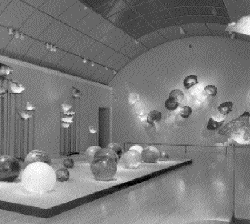
Sue Tallon Photography
Blown Coverage: Dale Chihuly's glass creations at the San Jose Museum of Art
The exquisite but much too
self-conscious blown-glass
extravaganzas of Dale Chihuly
By Ann Elliott Sherman
The godfather of modern American glass, Dale Chihuly, thinks big. By glass-blowing standards, the individual pieces in the San Jose Museum of Art's current retrospective of Chihuly's work are some of the largest ever fashioned by hand. Massed into groupings for installation in the vaulted expanse of the museum's new wing by team members from the artist's Seattle studios, the intent is to literally expand upon tradition, to render and present what is often a decorative art on a monumental, sculptural scale.
A former interior designer, Chihuly is acutely aware of the interaction of his glass pieces with the space around them, tailoring each installation to its location. The museum's soaring foyer and second-floor balcony provided Chihuly the opportunity to hang three enormous Venetian chandeliers where they can be seen both overhead and at eye level, as he prefers.
Each chandelier clusters a variation of an elongated bulb shape into a different biomorphic allusion--the flame-red piece suggests rams' horns; the azure resembles a jellyfish with trailing tentacles; and the yellow-to-chartreuse chandelier might be chiles hung to dry.
The huge chandeliers' quirky grace and carnival colors seem to presage a larger-than-life sensory experience. But, alas, instead of leaving one basking in an afterglow of seduction by color and light, Dale Chihuly: Installations 1964-1994 registers a benign shrug, much like being back home and in bed--alone--by 10 after an anticipated dinner date at a chic restaurant. Tasty, exquisitely presented, but with both the surroundings and the participants entirely too self-conscious, ain't nobody getting carried away.
"Glass is the most magical of all materials. It transmits light in a special way, and, at any moment, it might break," Chihuly is quoted in the show's catalog. Unlike some of his other noteworthy installations, such as the fragilely eerie Glass Forest--100 delicate, milk-glass stalks illuminated with neon and argon, resting only on the remnants of the molten-glass balls from which they were extruded--nothing in this show quite captures the visceral pleasure/anxiety charge unique to glass art.
The director of lighting for Nordstrom, who moonlights as Chihuly's lighting wizard, has effectively used the "long throw of light at low voltage" from aircraft landing lights to illuminate the ruffle-edged bowls mounted on steel supports of the Macchia Forest. The strangely lovely Macchia (Italian for "spotted"), with their irregular, cupped shapes like a strange floral hybrid of poppies and fritellaria, or perhaps some giant mollusk shell, seem to glow from within.
Their mottled, spotted exteriors lend an Impressionist effect, while the drenched colors lining the inside of the bowls approach an enameled, Fabergé patina. A sharply contrasting band of vivid color, or "lip wrap," along the edge adds a bit of contemporary zing.
Pretty as they are, the Macchia's carefully orchestrated placement along the gallery's fringes is much too controlled for a true forest effect, and the adaptation of their stands to the vertical dimensions of the room creates a sense of removal that dilutes their impact.
Perhaps the most successful wedding of Chihuly's dramatic flair and his predilection for taking his medium to its structural limits is the grouping of Persians along the central gallery's back wall. The Persians are hand-blown spheres that have been spun open--the edges asymmetrically curled or bent while still hot--into rippling blooms of variegated cobalt, gold, orange, brown. What captivates the kid in all of us is the way the wavy forms refract the light, glancing a kaleidoscope of color and shadow against the wall.
Chihuly's attempt to build--literally--upon this sensation by fashioning a Persian Pergola, however, fails on a grand scale. An arbor of steel girders supports a clear ceiling of laminated safety glass strewn with 438 pieces of blown glass--Persians, bulbs, cones, sea urchins, even cocktail glasses--illuminated from above.
Although the floor does occasionally receive a vague eddy of color here, a brief star burst there, there is no magic to it. All the disparate bits of glass don't lose their "thingness," despite being amassed with studied casualness. The result is rather like being buried alive beneath your Great Aunt Phoebe's cluttered Bombay chest in an earthquake.
What strikes you is just how American a glass master Chihuly is, borrowing from the glass-blowing traditions of various cultures. In addition to being the idea man behind the steady stream of artisans to come to apprentice with him at the Pilchuck Glass School he helped found or at his Boathouse factory in Seattle, he has also imported some of the greatest glass blowers in the world to be his collaborators. He is a puckish auteur of an international freelance glass-blowing conglomerate.
Ironically, whereas some of the glass artists of the post-Chihuly generation have pushed the medium's threshold of content and point of view, the works identified by the catalog as Chihuly's crowning achievement are idiosyncratic versions of that most fundamental of glass-blown pieces, the vessel.
Riffs on Art Deco vases he once saw in a Venice palazzo that were so rare as to be "almost uncollectable," his Venetians embellish boldly colored, elegant forms with over-the-top curlicues for a kind of Mae West effect. Displayed high upon the stairwell wall, they invite frustrated visitors to come up and see them sometime. Ultimately, though, they represent their creator: a practitioner of an ancient, undervalued art who mixes business with pleasure and imagination but little real emotional connection.
Dale Chihuly: Installations 1964-1992 runs through Jan. 21 at the San Jose Museum of Art, 110 S. Market St., San Jose. (408/271-6840).
[ Metro | Metroactive Central ]
